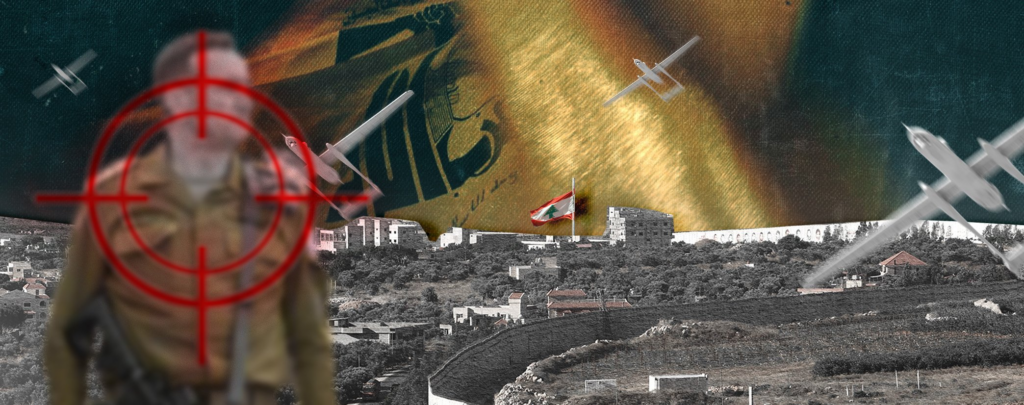
On 17 April, Hezbollah launched a series of qualitative military operations on the western sector of the Lebanese–Israeli border, culminating in a sophisticated attack using guided missiles and an explosive-laden drone that struck the headquarters of an Israeli reconnaissance unit in the village of Arab al-Aramshe.
The attack resulted in 18 casualties, some serious, including an enemy general who succumbed to his wounds, according to Israeli reports.
The primary aim of these operations was to deliver a stern message to Israel: further targeted killings of Hezbollah members will not be tolerated. The resistance’s response was specifically provoked by the assassination of its fighters in the villages of Ain Baal and Chehabiya the previous day, where Israeli drone strikes martyred several fighters in quick succession.
Hezbollah strikes, Israel reacts
On the morning of the retaliatory operation, Hezbollah executed additional notable attacks in the western sector. These included striking the Branit barracks with a powerful Burkan missile and launching an Almas-3 missile at the Meron base’s air control unit, marking the first reported use of this missile with a range exceeding 10 kilometers.
The attack also destroyed an AN/TPQ-37, a radar crucial for detecting projectiles and identifying their origins.
Despite its initial reluctance, the Israeli military acknowledged the operation, following the overwhelming evidence presented in numerous video recordings. The operation, as with many by Hezbollah as of late, was a qualitative response, drawing significant media attention and analysis in Israel.
Prominent commentators noted that Hezbollah had effectively circumvented Israeli warning systems and struck at will, indicating that previous assassinations by Israel did not deter Hezbollah’s strategic operations.
The Arab al-Aramshe operation is being carefully analyzed by Israeli media, both concerning Hezbollah’s tactics and Israel’s responses. Israel’s Channel 12 outlet, in particular, emphasized two major points:
First, Hezbollah learns rapidly from past engagements and introduces new tactics and weapons into the battlefield. This was demonstrated by its deployment of heavy Burkan missiles against Israeli army bases, marking a shift in its approach and showcasing its ability to innovate and apply new technologies in combat scenarios.
Second, the Lebanese resistance movement’s ability to effectively combine multiple weapon systems simultaneously to target a specific location was also noted. This strategy aims to overwhelm the enemy’s defensive measures and maximize impact.
Further insight was provided by a military correspondent from the Hebrew newspaper Makor Rishon, who pointed out that Israel’s numerous assassinations of Hezbollah members have neither deterred nor significantly affected the organization’s ability to carry out sophisticated strikes against sensitive Israeli military points.
Essentially, the Hebrew media depiction paints a picture of concern over the Israeli army’s current military strategies and their effectiveness. Streams of articles now conclude that neither deep raids into Lebanese territory nor the targeting of Hezbollah’s operational capabilities has prevented the organization from accessing and utilizing advanced weaponry or executing coordinated attacks.
Hezbollah’s intelligence gathering
The intelligence capabilities of Hezbollah are clearly robust and have been cultivated over many years. This level of intelligence gathering has been highlighted by the group’s Secretary-General Hassan Nasrallah, who once pointedly messaged the Israelis:
It is not important what you know about the resistance, but what the resistance knows about you.
The Arab al-Aramshe operation is a compelling illustration of these capabilities. Hezbollah’s prior knowledge of a relatively new reconnaissance site and subsequent successful strike showcase its meticulous intelligence work.
This is by no means an isolated case; similar intelligence-driven operations have targeted other critical Israeli military assets, including operational headquarters and Iron Dome positions across different locations.
Hezbollah has also been able to identify and strike at highly sensitive and less visible targets. This includes military bases like the “Yaav” base and the “Kila” barracks in the occupied Golan Heights, known to be the headquarters of Israel’s air and missile defense command. These sites were specifically targeted following the return of forces from the Golani Brigade, who were training there after committing war crimes in the Gaza Strip.
The complexity of Hezbollah’s intelligence operations lies in its clarity and ambiguity. While the targets of its operations are clear, how it gathers such detailed and specific intelligence remains largely undisclosed and mysterious.
This capability to identify and act upon vulnerabilities deep within Israeli territory points to a sophisticated network of intelligence gathering and analysis, likely involving both technological surveillance and human intelligence.
Raising the stakes
Hezbollah aimed to achieve several objectives through the combined strike in Arab al-Aramshe. These goals include deterring Israel’s assassinations of resistance fighters and asserting the resistance’s focus on hitting significant, high-value targets to inflict substantial losses.
Additionally, Hezbollah demonstrated its capability to gather detailed intelligence, enabling it to pinpoint sensitive and strategic enemy locations.
The escalation of resistance activities aims to set boundaries for the Israeli military, which has continued its strategy of assassinations and attacks against Lebanese civilians and state agricultural areas. Moreover, these actions on the Lebanese front are designed to bolster and support the resistance in the Gaza Strip.
It is through the deployment of various weapons and military tactics that Hezbollah continues to pursue its objective of challenging and restraining Israeli aggression toward Lebanon while simultaneously supporting the Palestinian resistance in Gaza – both politically and militarily – since the launch of Al-Aqsa Flood last year.
